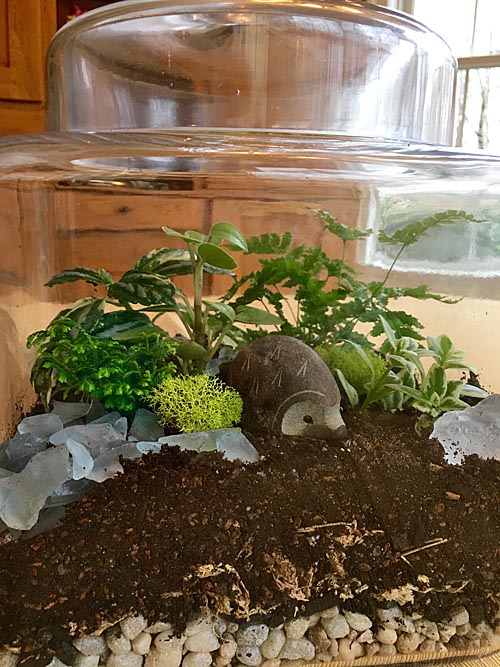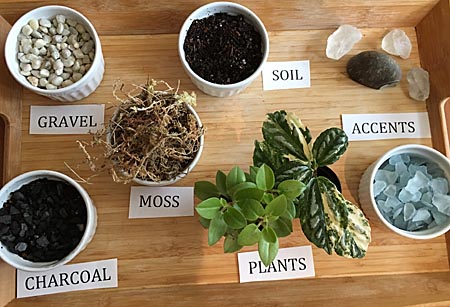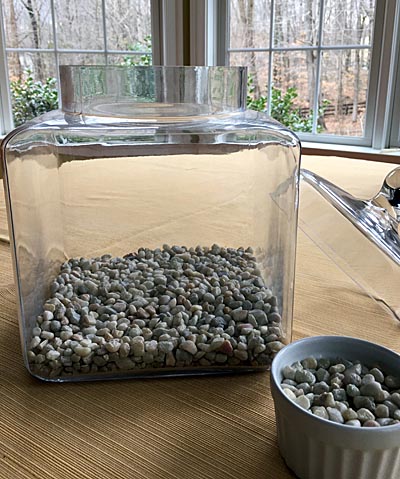Terrariums: Quick Fix for Winter-Weary Gardeners
By Jo Anna Natale, Fairfax Master Gardener
 No matter how many seed catalogs skimmed or new spring beds plotted, sometimes a gardener can’t seem to quell the wintertime urge to arrange real plants in real dirt.
No matter how many seed catalogs skimmed or new spring beds plotted, sometimes a gardener can’t seem to quell the wintertime urge to arrange real plants in real dirt.
A terrarium can help. Creating one of these miniature gardens, surrounded by glass, lets you plan, tend and meditate upon a landscape of your own making. It’s small scale, for sure, but an easy way to treat garden fever until spring, when you can get outdoors and do so on a grand scale.
Terrariums have been around some 2,500 years, according to some sources, but they were especially popular in Victorian times and have recaptured interest in recent years. You can easily buy readymade ones in garden centers, boutiques and Etsy stores, but creating your own terrarium is more fun and less expensive, and it requires only an hour of hands-on construction time. Plus, it gets you out of your frosty funk.
The goods
Deciding which container to use is perhaps the toughest part. Opt for rustic or elegant, traditional or modern to suit your style, but make sure your container has clear glass with a mouth wide enough to accommodate a hand or two inside. If the container does not have a top, you will have an open terrarium, which is best suited for plants that prefer sunnier, drier conditions, such as succulents. Open containers can be anything from aquariums to vases to classic terrarium bowls with slanted mouths. A container with a lid or top will work best with plants that prefer humid conditions, such as ferns. For the closed type, try using a large Mason jar or pickle jar, or you can search for more decorative possibilities at yard sales or discount home stores. Whatever container you select, wash it in soap and water, then rinse and dry it before proceeding.
Next, collect the terrarium’s components, available at garden and craft stores. You will need:
- Gravel — to provide drainage
- Activated charcoal — to help filtration and prevent odor
- Sphagnum moss –- to separate soil and drainage layers
- Sterile potting soil (or cactus soil, if using succulents) -– to serve as growing medium
- Small plants suitable for terrariums –- to put life in the landscape
- Figurines, stones, colored glass or other accents — to give your tiny garden whimsy
 When choosing plants, follow the same design guidelines you would employ outdoors, varying plant height and leaf shape, texture and color. Select an odd number of plants to fill — not crowd — your container. And remember, stick to plants with similar cultural requirements. For example, decide to use plants that like moist conditions and low light or plants that prefer dry conditions and bright light. Check plant tags to determine their needs.
When choosing plants, follow the same design guidelines you would employ outdoors, varying plant height and leaf shape, texture and color. Select an odd number of plants to fill — not crowd — your container. And remember, stick to plants with similar cultural requirements. For example, decide to use plants that like moist conditions and low light or plants that prefer dry conditions and bright light. Check plant tags to determine their needs.
The process
You will assemble the terrarium lasagna-style. First, evenly spread about an inch of gravel in the bottom of the container, and then top this with a thin layer of activated charcoal. (Use a spoon or fork as a tool.) Next, spread a layer of sphagnum moss that has been moistened and squeezed dry. Top the moss with a depth of potting soil that will cover your plants’ roots. Keep in mind that all these layers combined should take up about a third of the total depth of the container, so that the plants will have room to grow.
 Now, the fun part: Tip your plants from their pots, loosening any bound roots. Using a fork or a few fingers, dig holes in the soil and arrange the greenery in a way that pleases. Consider the view from all angles. When planting, make sure to cover the plants’ roots, firming the surrounding soil. Finally, arrange the accents however you like –- a stone creature here, a fairy figurine there, with maybe a touch of colored glass or moss to complement the greenery.
Now, the fun part: Tip your plants from their pots, loosening any bound roots. Using a fork or a few fingers, dig holes in the soil and arrange the greenery in a way that pleases. Consider the view from all angles. When planting, make sure to cover the plants’ roots, firming the surrounding soil. Finally, arrange the accents however you like –- a stone creature here, a fairy figurine there, with maybe a touch of colored glass or moss to complement the greenery.
That’s it — except for caring for the terrarium. Most terrariums do best placed in moderate, indirect light, but again, consult plant labels for guidance. The other important consideration is water. If you have an open terrarium, water your plants lightly once a week or so but only when the soil is beginning to feel dry. A closed container will require water less often. If the soil feels dry, give the plants a modest drink. Afterwards, keep the terrarium’s top off until the leaf surfaces dry. In fact, it’s a good idea to remove the top occasionally –especially when you see heavy condensation building on the glass — to discourage too much moisture. Doing so will help prevent disease.
As the plants grow, prune them with small clippers or scissors to keep the arrangement in bounds. And if one plant fails, replace it with another, just as you would in your perennial bed. With some luck and a bit of attention, your terrarium will not only help you get through this long winter, it should thrive through many seasons to come.
Resources
Terrariums, University of Missouri Extension, G6520
Nature in Miniature: Terrariums, University of Maryland Extension
Terrariums: Gardens in Glass, University of Vermont Extension The Art of Terrariums